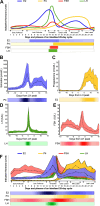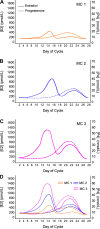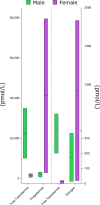Menstrual cycle hormones and oral contraceptives: a multimethod systems physiology-based review of their impact on key aspects of female physiology
- PMID: 37823207
- PMCID: PMC10979803
- DOI: 10.1152/japplphysiol.00346.2023
Menstrual cycle hormones and oral contraceptives: a multimethod systems physiology-based review of their impact on key aspects of female physiology
Abstract
Hormonal changes around ovulation divide the menstrual cycle (MC) into the follicular and luteal phases. In addition, oral contraceptives (OCs) have active (higher hormone) and placebo phases. Although there are some MC-based effects on various physiological outcomes, we found these differences relatively subtle and difficult to attribute to specific hormones, as estrogen and progesterone fluctuate rather than operating in a complete on/off pattern as observed in cellular or preclinical models often used to substantiate human data. A broad review reveals that the differences between the follicular and luteal phases and between OC active and placebo phases are not associated with marked differences in exercise performance and appear unlikely to influence muscular hypertrophy in response to resistance exercise training. A systematic review and meta-analysis of substrate oxidation between MC phases revealed no difference between phases in the relative carbohydrate and fat oxidation at rest and during acute aerobic exercise. Vascular differences between MC phases are also relatively small or nonexistent. Although OCs can vary in composition and androgenicity, we acknowledge that much more work remains to be done in this area; however, based on what little evidence is currently available, we do not find compelling support for the notion that OC use significantly influences exercise performance, substrate oxidation, or hypertrophy. It is important to note that the study of females requires better methodological control in many areas. Previous studies lacking such rigor have contributed to premature or incorrect conclusions regarding the effects of the MC and systemic hormones on outcomes. While we acknowledge that the evidence in certain research areas is limited, the consensus view is that the impact of the MC and OC use on various aspects of physiology is small or nonexistent.
Keywords: endocrinology; exercise; female; human; menstrual cycle.
Conflict of interest statement
S.M.P. reports personal fees from Nestle Health Sciences and nonfinancial support from Enhanced Recovery outside the submitted work. S.M.P. has patents licensed to Exerkine but reports no financial gains from patents or related work. M.A.T. is President and CEO of Exerkine Corporation who develops postexercise recovery drinks for athletes but none that are sex-specific. None of the other authors has any conflicts of interest, financial or otherwise, to disclose.
Figures







References
-
- Kuikman MA, Smith ES, McKay AKA, Ackerman KE, Harris R, Elliott-Sale KJ, Stellingwerff T, Burke LM. Fueling the female athlete: auditing her representation in studies of acute carbohydrate intake for exercise. Med Sci Sports Exerc 55: 569–580, 2023. doi:10.1249/mss.0000000000003056. - DOI - PMC - PubMed
-
- Smith ES, McKay AKA, Kuikman M, Ackerman KE, Harris R, Elliott-Sale KJ, Stellingwerff T, Burke LM. Managing female athlete health: auditing the representation of female versus male participants among research in supplements to manage diagnosed micronutrient issues. Nutrients 14: 3372, 2022. doi:10.3390/nu14163372. - DOI - PMC - PubMed
-
- Smith ES, McKay AKA, Kuikman M, Ackerman KE, Harris R, Elliott-Sale KJ, Stellingwerff T, Burke LM. Auditing the representation of female versus male athletes in sports science and sports medicine research: evidence-based performance supplements. Nutrients 14: 953, 2022. doi:10.3390/nu14050953. - DOI - PMC - PubMed
Publication types
MeSH terms
Substances
Associated data
Grants and funding
LinkOut - more resources
Full Text Sources
Medical

